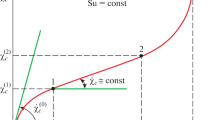A nonlinear model of the process of low-temperature discontinuous yielding of metals has been constructed, which allows the totality of strain jumps to be described as a function of the mechanical properties of material and dynamic characteristics of the loading system. The adequacy of the model has been experimentally verified for austenitic steel and an aluminum alloy.






Similar content being viewed by others
Notes
In the case where the P 0 values in the maximum load region of the deformation curve do not practically change, which is valid for the materials that are plastic at cryogenic temperatures.
This is temperature increment at the jump occurring approximately in the middle of deformation curve.
References
V. V. Pustovalov, “Jumplike deformation of metals and alloys at low temperatures (review),” Fiz. Nizk. Temper., 34, No. 9, 871–913 (2008).
E. E. Deryugin, V. E. Panin, G. V. Lasko, and Z. Shmauder, “Modeling of the discontinuous yielding of polycrystals by the relaxation element method,” Fiz. Mezomekh., 9, No. 1, 21–24 (2006).
L. P.Cubin, Ph. Spiesser, and Y. Estrin, “Computer simulation of the low temperature instability of plastic flow,” Acta Met., 30, No. 2, 385–394 (1982).
K. Neelkantan and G. Venkataraman, “Instability associated with repeated yield drop,” Acta Met., 31, No. 1, 77–85 (1983).
V. A. Strizhalo and E. V. Vorob’ev, “Simulation of low-temperature discontinuous yield by the method of additional pulse loading,” Strength Mater., 29, No. 3, 269–274 (1997).
V. V. Demirski and S. N. Komnik, “On the kinetics of stress jumps during plastic deformation of crystals,” Acta Met., 30, No. 12, 2227–2232 (1982).
M. M. Krishtal, “Interrelation between the instability and mesoscopic inhomogeneity of plastic deformation. III. Modeling and analysis of discontinuous yielding with allowance for its dependence on the degree of strain and extension rate,” Fiz. Metal. Metalloved., 100, No. 3, 12–21 (2005).
V. A. Strizhalo and E. V. Vorob’ev, “Low-temperature interrupted yield of structural alloys,” Strength Mater., 25, No. 8, 576–583 (1993).
E. V. Vorob’ev and V. A. Strizhalo, “Development of low-temperature jumpwise deformation of metals and possibilities of its elimination,” Strength Mater., 31, No. 1, 28–37 (1999).
V. A. Strizalo, L. S. Novogrudskii, and E. V. Vorob’ev, Strength of Materials at Cryogenic Temperatures with Allowance for the Action of Electromagnetic Fields [in Russian], Vol. 1, Pisarenko Institute of Problems of Strength, National Academy of Sciences of Ukraine, Kiev (2008).
E. V. Vorob’ev, “Peculiarities of neck formation under low-temperature discontinuous yield of metals. Part 1. Axisymmetric deformation,” Strength Mater., 40, No. 3, 350–355 (2008).
Yu. P. Solntsev, B. S. Ermakov, and O. I. Sleptsov, Materials for Low and Cryogenic Temperatures. Encyclopedic Reference Book [in Russian], Khimizdat, St. Petersburg (2008).
N. V. Novikov, N. V. Filin, N. I. Gorodyskii, et al., Strength of Material and Structures of Cryogenics [in Russian], Naukova Dumka, Kiev (1992).
V. Ya. Il’ichev, I. N. Klimenko, S. M. Dergun, and K. A. Yushchenko, “Temperature dependence of the yield point of stainless steels at low temperatures,” Strength Mater., 13, No. 3, 325–327 (1981).
V. O. Strizhalo and E. V. Vorobyov, “Energy transformations during the low-temperature discontinuous flow of metals,” Fiz.-Khim. Mekh. Mater., No. 5, 71–74 (2002).
E. V. Vorob’ev and T. V. Anpilogova, “Determination of the form and parameters of disturbing action function in the mathematical model of the process of low-temperature jumplike deformation of metals,” in: Reliability and Durability of Machines and Constructions [in Ukrainian], (2007), No. 28, pp. 131–139.
N. S. Bakhvalov, Numerical Methods. Educational Book [in Russian], Nauka, Moscow (1987).
V. I. Startsev, V. Ya. Il’ichev, and V. V. Pustovalov, Ductility and Strength of Metals and Alloys at Low Temperatures [in Russian], Metallurgiya, Moscow (1975).
Author information
Authors and Affiliations
Additional information
Translated from Problemy Prochnosti, No. 1, pp. 109 – 121, January – February, 2011.
Rights and permissions
About this article
Cite this article
Vorob’ev, E.V., Anpilogova, T.V. Modeling of the process of low-temperature jumplike deformation of metals. Strength Mater 43, 77–86 (2011). https://doi.org/10.1007/s11223-011-9270-4
Received:
Published:
Issue Date:
DOI: https://doi.org/10.1007/s11223-011-9270-4




